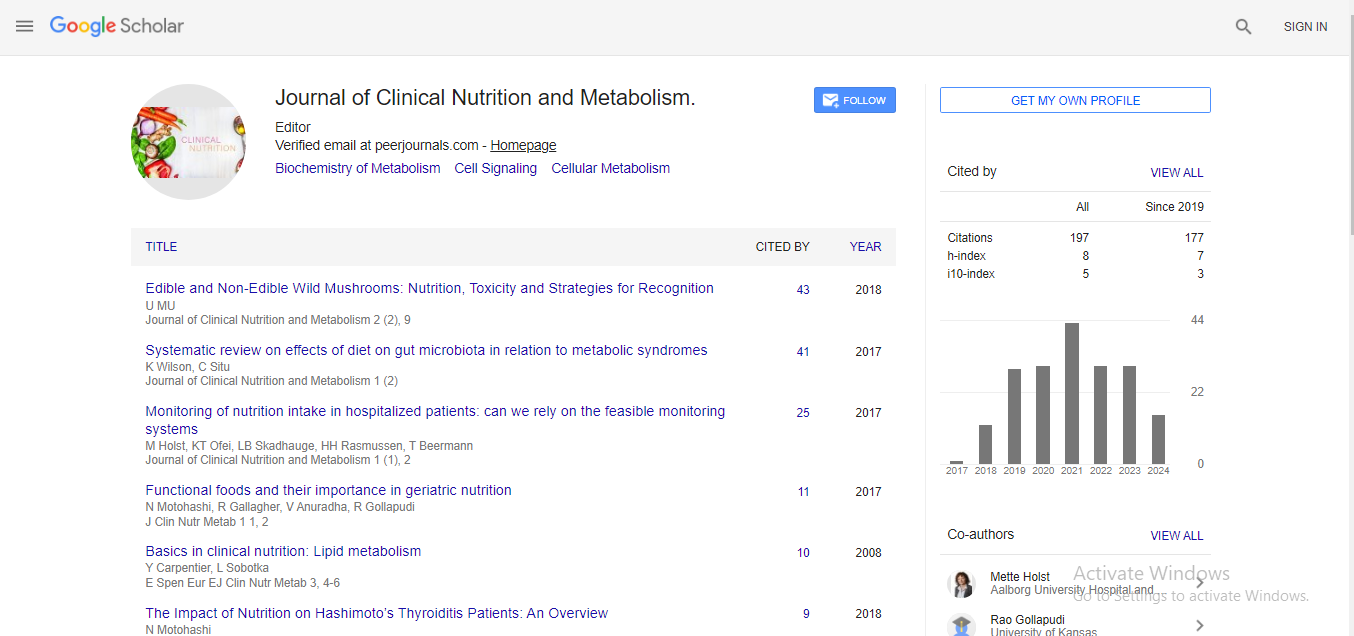Short Communication, J Clin Nutr Metab Vol: 4 Issue: 3
Clinical Nutrition 2017: Heavy metals in Georgian red wines Kindzmarauli and Saperavi - L Akhalbedashvili- Ivane Javakhishvili Tbilisi State University
N Kekelidze, T Kekelidze, L Akhalbedashvili, M Mirtskhulava, G Maisuradze, B Kvirkvelia, G Tsotadze and V Liparteliani Ivane Javakhishvili Tbilisi State University, Georgia
Keywords: Heavy metals, Clinical Nutrition
At valuation security of wines, extraordinary job ought to be given to investigative control of poisons, for example, overwhelming metals (HM) which possibly have poisonous and cancer-causing properties. In this way, significant is the assurance of their substance in wines and evaluation of impact on edge of their toxicological consequences for living life form. Substance of HM in wines rely upon kind of soil, handling states of vineyard, climatic conditions, vinification, anthropogenic factors, etc. In work, first, the drive of overwhelming metals Pb, Cu, Zn, Cd, Co, Ni, Mn in a chain: soil→stem→skin→pulp→wines Kindzmarauli and Saperavi from remarkable vineyards Mukuzani and Sabue of Kakheti district of Georgia were considered. Every single strong example were treated by strategy for dry mineralization. To decide the HM content in tests, nuclear assimilation spectrophotometry (PerkinElmer Analyst 200) was utilized. With expanding profundity of soil from 5 to 50 sm HM substance diminished in Mukuzani vineyard: Cu from 53.65 till 42.6mg kg-1 in and Zn from 78.5 to 67.1mg kg-1, yet in cleaner area Sabue vineyard, substance of all components examined expanded a little with expanding profundity. In chain, soil →stem→skin→pulp →wines, the amount of HM diminished, in excess of a request, however nonextraordinarily. In leaves, substance of Cu and Fe in 5-10 times win their substance in soil and skin, in juice and wine diminished in multiple times. It is realized that the utilization of copper containing fungicides for the sickness control of plants could likewise prompt increment in the Cu measures of grapes, just as of the items acquired from their preparing. In any case, in Georgian wines, the substance of all HM not wins 0.2 mg/l.). The majority of HM in the grapes hastens during maturation into residue, which is the explanation behind their fundamentally lower content in the wine. The point of the examination was to decide the subjective and quantitative arrangement of phenolic mixes (PC) in various pieces of grape Sapheravi (stem, skin, mash, and seed) and in wines, acquired by Kakhetian and European techniques utilizing superior fluid chromatography (HPLC). The red wines Kindzmarauli and Saperavi contain the accompanying PC: chromogenic corrosive, caffeic, vanillic, lilac, wax acids, lilac aldehyde, quercetin-3- β-D-glucoside, vanillin, catechins, myricetin, quercetin. Gallic, ferulic and p-coumaric acids were not found. The all out substance of PC in skin concentrates and wine were lower than in seed and stem more than in multiple times, all the more piece of PC in stems and seeds are phenolic acids, and a less amount of flavonoids. The substance of resveratrol in examined wines changes from 7.9 to 18.6 mg/L, and is equivalent 200.3 mg/L for stem of Saperavi grape, 338 mg/L in skin grape and 273 in seeds. Fewer catechins in wine, acquired by Kakhetian technique in correlation with European one, demonstrate on progressively serious oxidation process in Qvevri. The segment of action of the most notable disease anticipation specialists (sweet-smelling amines, phenols, naphthols, etc.) is that the reaction chains break: the cell fortification particles speak with the dynamic radicals to shape low-development radicals. Oxidation is in like manner moved down inside seeing substances that pound hydroperoxides (dialkyl sulfides, etc.). For this circumstance, the pace of course of action of free radicals decreases. For sure, even in a restricted amount (0.01-0.001%), cell This work is partly presented at 14th International Conference on Clinical Nutrition July 27-29, 2017 held at Rome, fortifications abatement the pace of oxidation, hence, during a particular time period (the hour of limitation, acknowledgment), oxidation things are not perceived. In the demonstration of restriction of oxidative methods, the miracle of agreeable vitality is imperative - shared improvement of the ampleness of disease counteraction specialists in the mix or inside seeing various substances. In characteristic systems, malignant growth anticipation operators are substances that can control techniques of free extraordinary oxidation. For living cells, the most perilous is the chain oxidation of polyunsaturated unsaturated fats, or lipid peroxidation (LPO). In LPO reactions, incalculable lipid hydroperoxides are encircled, which have a high reactivity and have an inconceivable hurting sway on the cell. Conclusion: Considering the eventual outcomes of the assessment of wines and beginning wine materials and differentiating them and some composing data, we surmised that the geographic region, climate, soil type, and especially the grape kind, and getting ready development, decidingly affect the substance of phenolic blends in the Saperavi wines thought about. Along these lines, the quirk of these wines is the nonattendance of gallic, ferulic, p-coumaric acids instead of other red wines, a basic substance of flavonols and a lower substance of phenolic acids in wines than in skin and seeds.
 Spanish
Spanish  Chinese
Chinese  Russian
Russian  German
German  French
French  Japanese
Japanese  Portuguese
Portuguese  Hindi
Hindi 